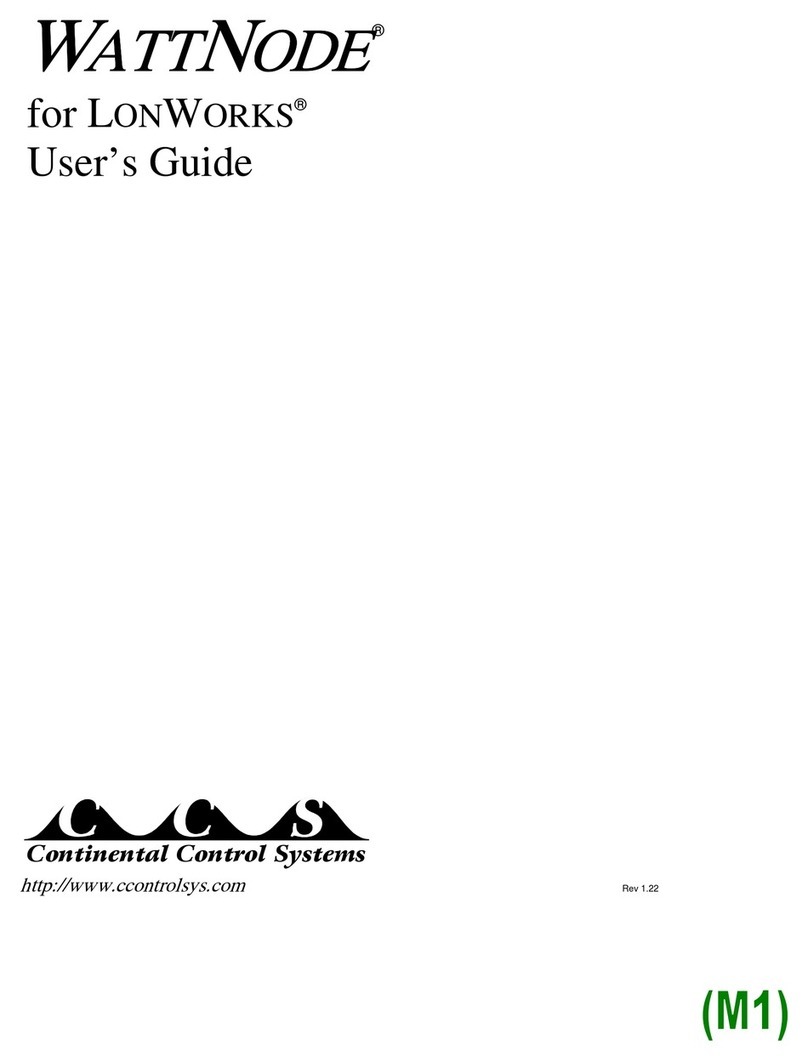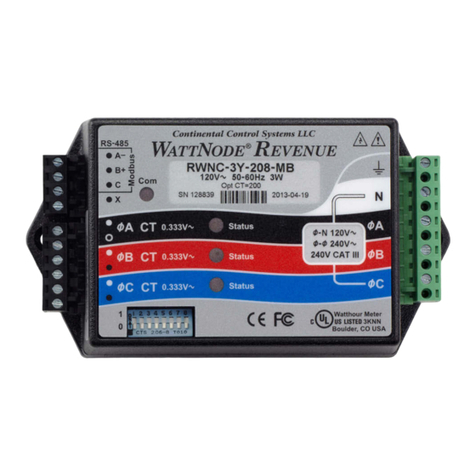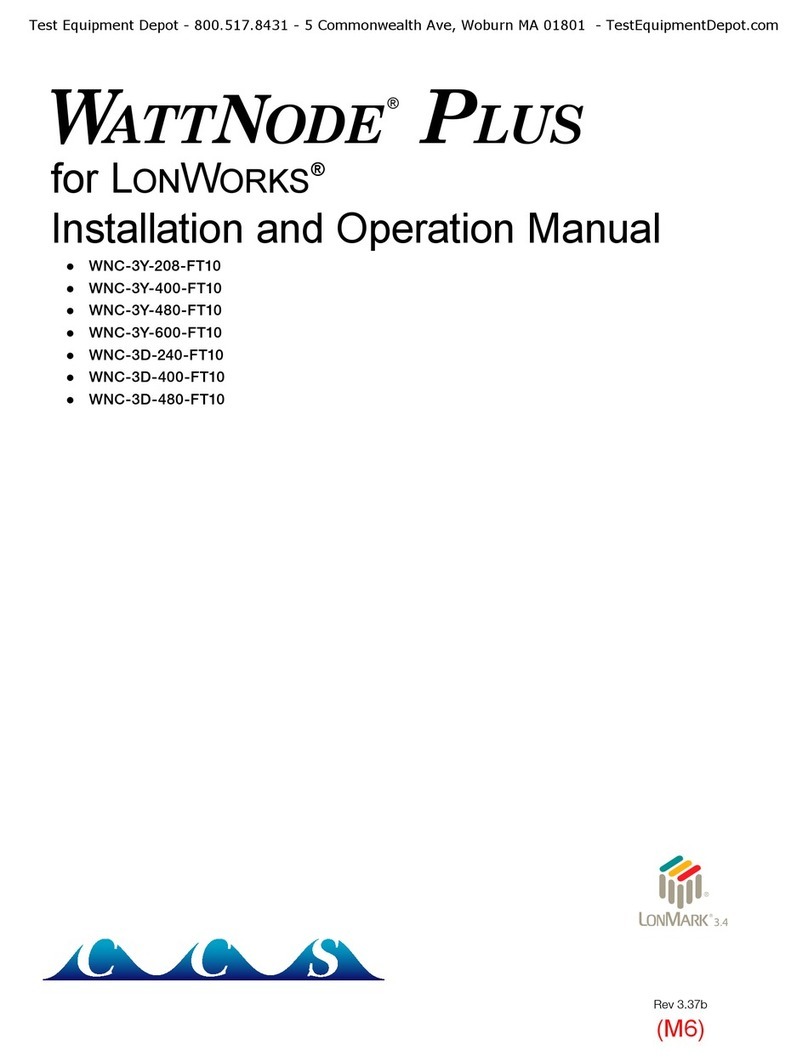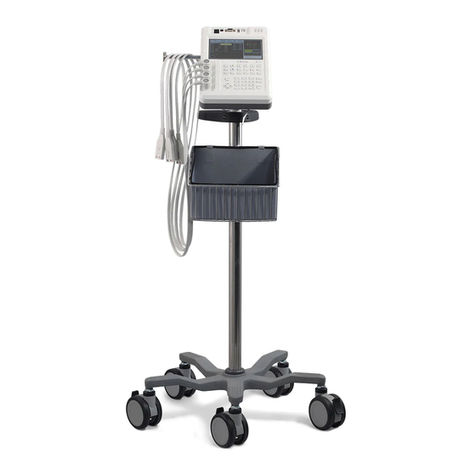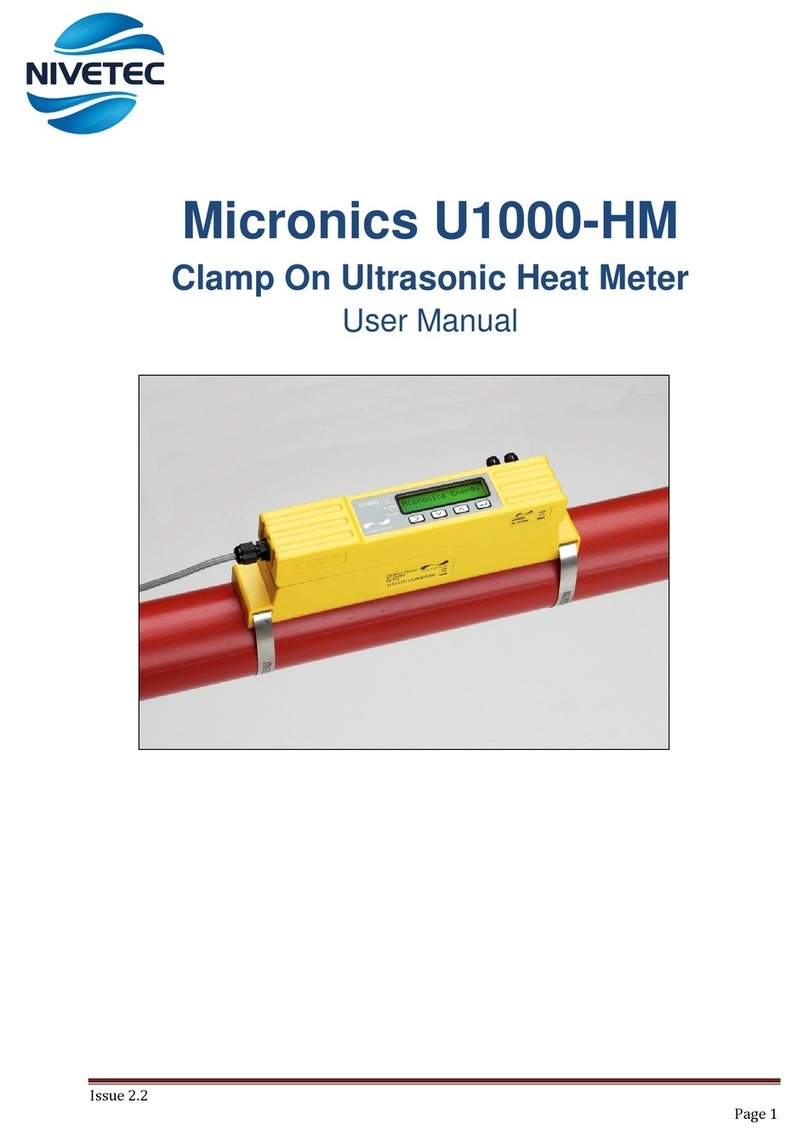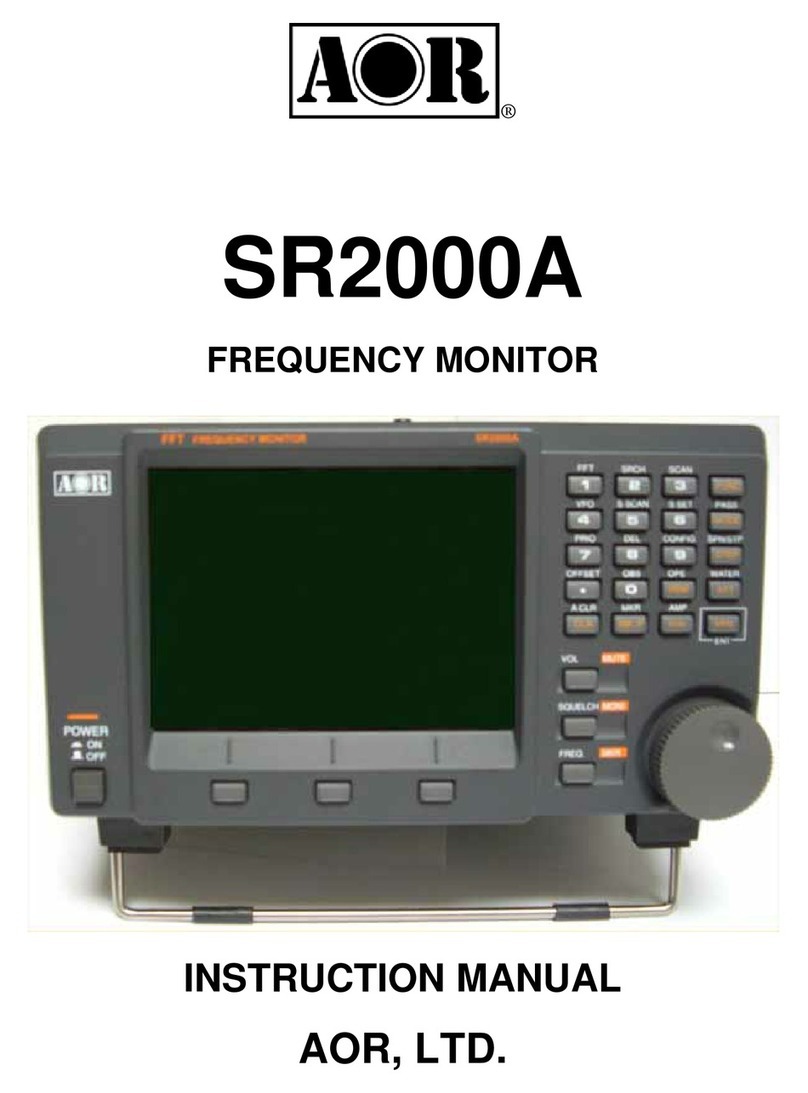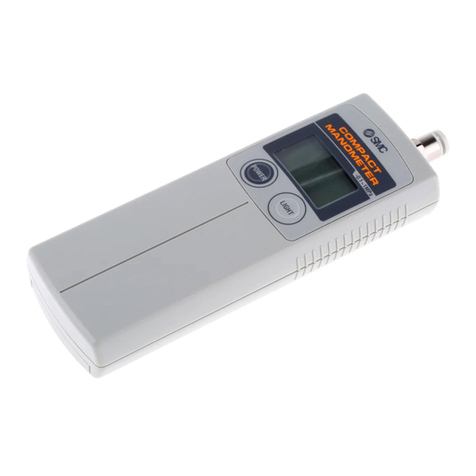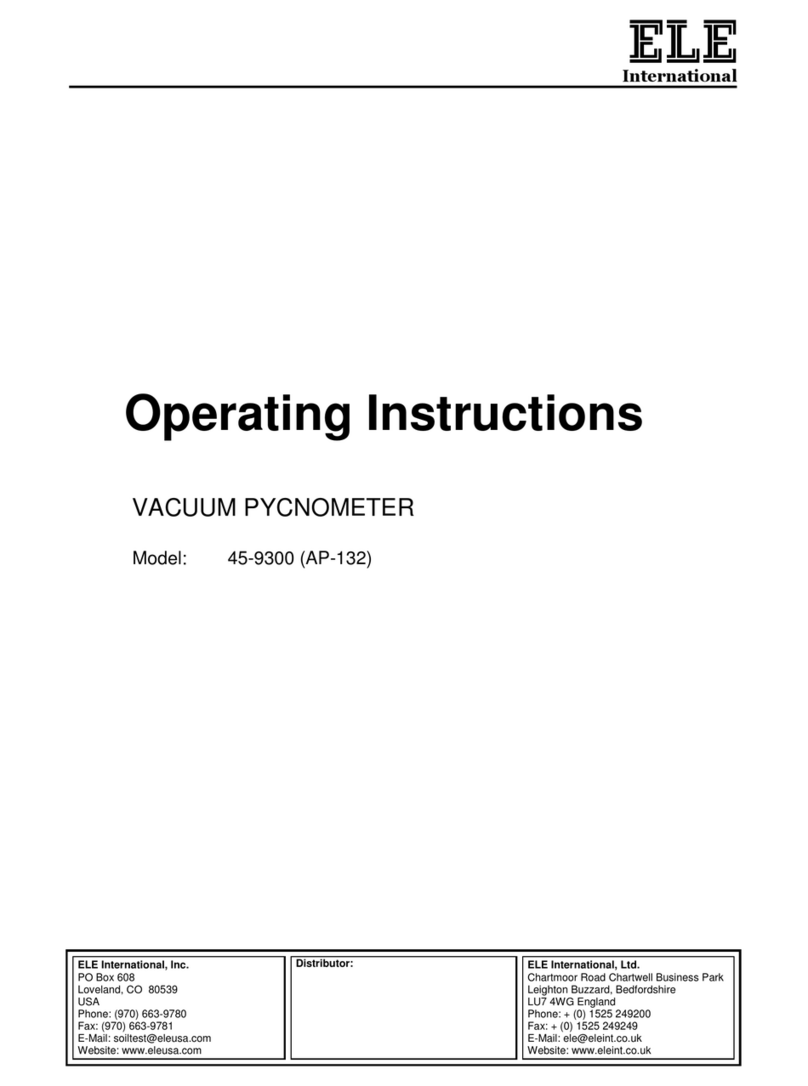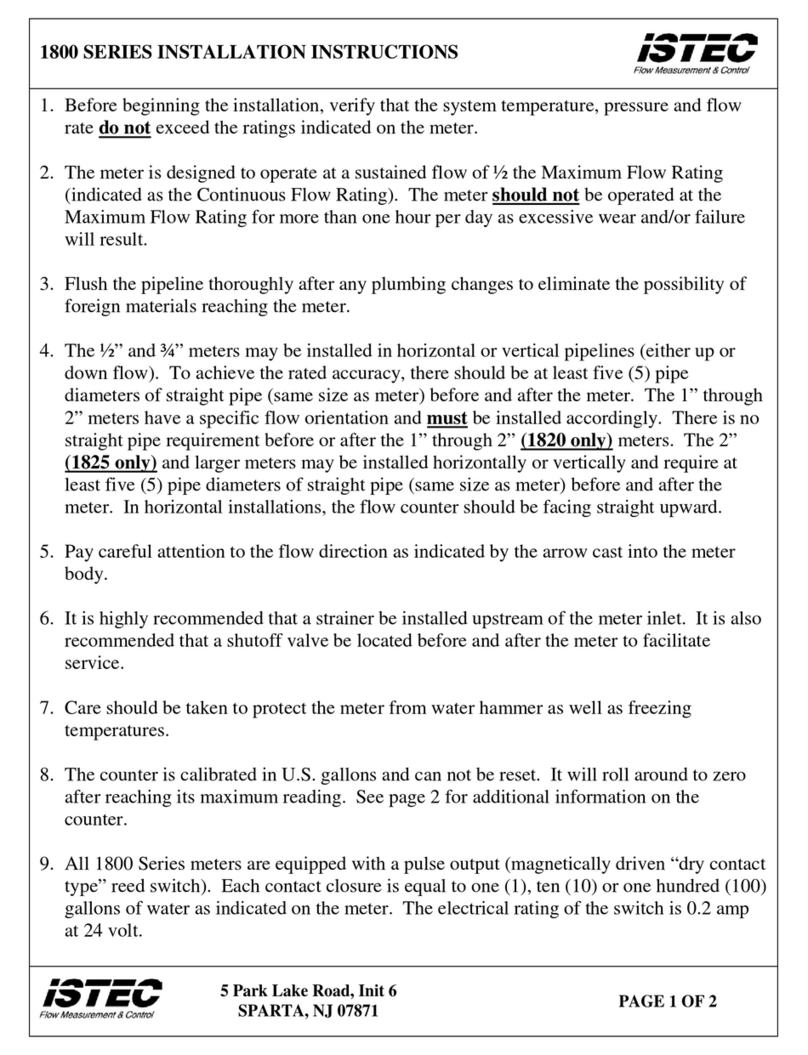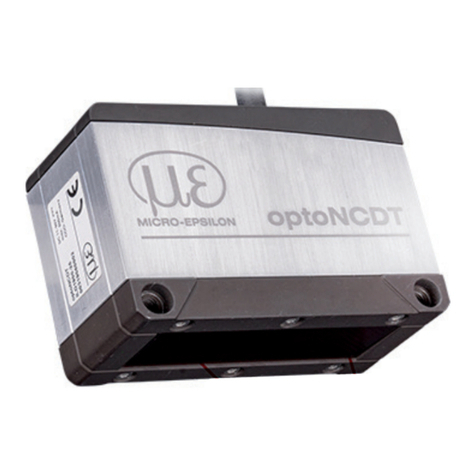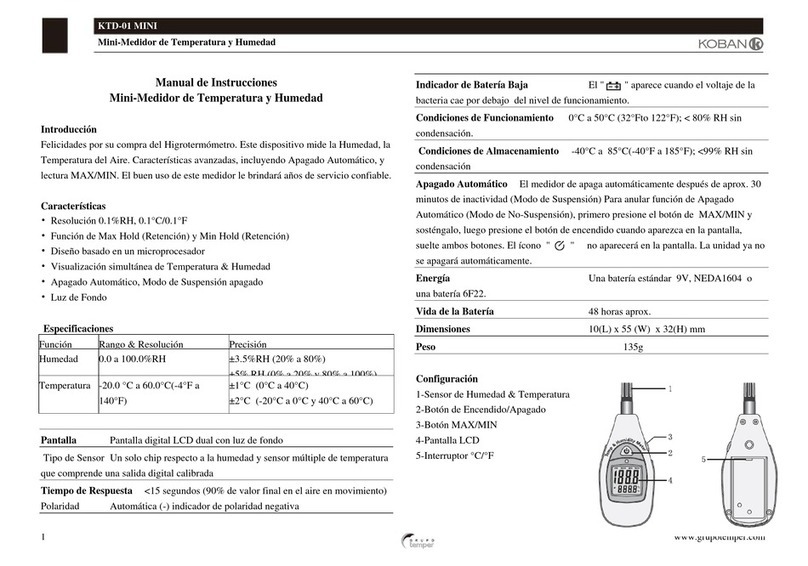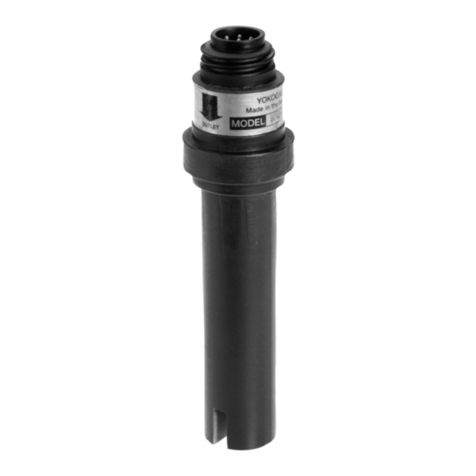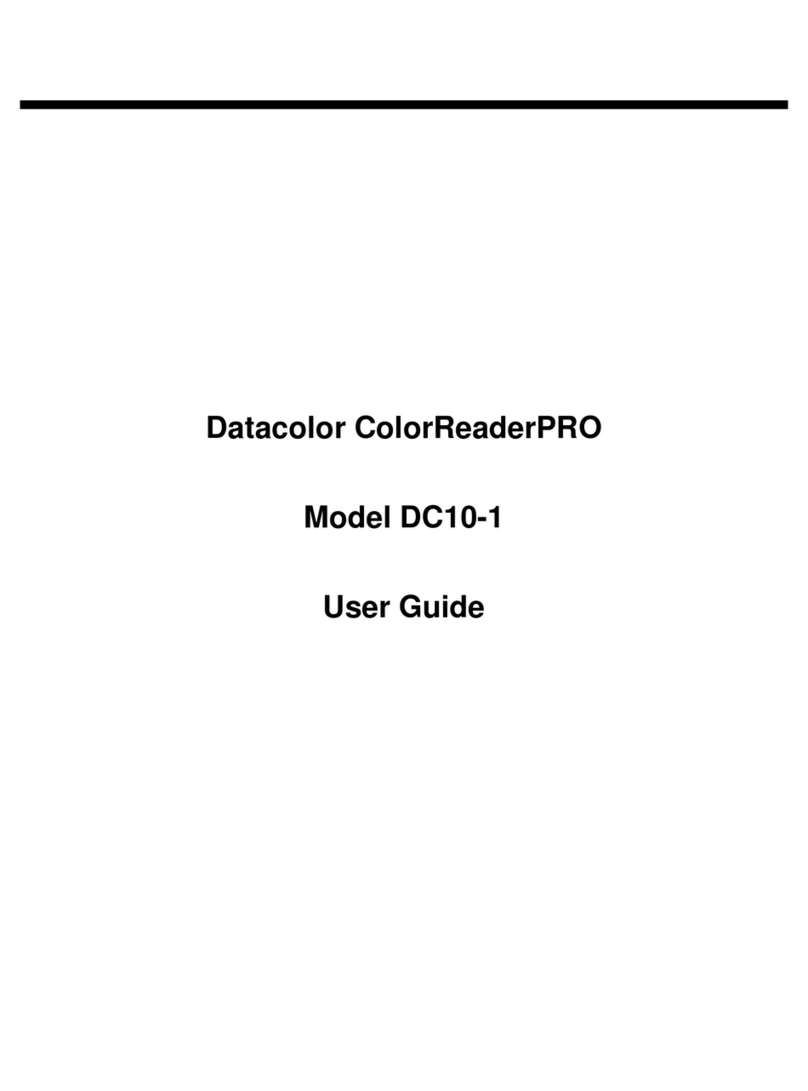CCS WattNode WND-WR-MB User manual

Page 2 of 16 WND-WR-MB-Inst-1.03
Contents
1 Precautions...............................................................................................................................3
1.1 Symbols......................................................................................................................................3
2 Overview....................................................................................................................................3
2.1 Additional Literature....................................................................................................................3
2.2 Electrical Service Types .............................................................................................................4
3 Installation.................................................................................................................................6
3.1 Installation Checklist...................................................................................................................6
3.2 Mounting.....................................................................................................................................7
3.3 Connect Voltage Terminals.........................................................................................................7
3.4 Connect Current Transformers...................................................................................................7
3.5 RS-485 Communication .............................................................................................................8
4 Operation.................................................................................................................................10
4.1 Initial Configuration...................................................................................................................10
4.2 Power Status LEDs ..................................................................................................................10
4.3 Modbus Communication LED...................................................................................................11
4.4 Monitoring.................................................................................................................................12
4.5 Maintenance and Repair ..........................................................................................................12
5 Specifications.........................................................................................................................12
5.1 Measurement............................................................................................................................12
5.2 Electrical...................................................................................................................................12
5.3 EIA RS-485 Interface................................................................................................................13
5.4 Certifications.............................................................................................................................13
5.5 Environmental...........................................................................................................................14
5.6 Mechanical ...............................................................................................................................14
5.7 FCC Information.......................................................................................................................14
5.8 Warranty...................................................................................................................................16
5.9 Limitation of Liability.................................................................................................................16

WND-WR-MB-Inst-1.03 Page 3 of 16
1 Precautions
●Only qualified personnel or licensed electricians should install the WattNode meter. The mains
voltages of 100 to 600 Vac can be lethal!
●Follow all applicable local and national electrical and safety codes.
●The terminal block screws are not insulated. Do not contact metal tools to the screw terminals if
the circuit is live!
●Verify that circuit voltages and currents are within the proper range for the meter model.
●Use only UL Listed or Recognized current transformers (CTs). Depending on the meter options,
you may use either CTs with built-in burden resistors that generate 0.333 Vac (333 millivolts AC)
at rated current or milliamp output CTs that generate 40 mA at rated current. Do not use 1 amp
or 5 amp output CTs: they will destroy the meter and may create a shock hazard.
●Protect the line voltage conductors to the meter with fuses or circuit breakers. See 3.3.1 below.
●Disconnect equipment from HAZARDOUS LIVE voltages before access.
●If the meter is not installed correctly, the safety protections may be impaired.
1.1 Symbols
Read, understand, and follow all instructions including warnings and precautions
before installing and using the product.
Potential Shock Hazard from Dangerous High Voltage.
Functional ground; should be connected to earth ground if possible, but is not re-
quired for safety grounding.
UL Listing mark for U.S.A. and Canada.
FCC Mark. This logo indicates compliance with part 15 of the FCC rules.
Complies with the regulations of the European Union for Product Safety and Electro-
Magnetic Compatibility.
• Low Voltage Directive – EN 61010-1:2010 (3rd Edition)
• EMC Directive – EN 61326-1:2013
V~This indicates an AC voltage.
2 Overview
Congratulations on your purchase of the WattNode®Wide-Range Modbus®watt/watt-hour meter.
One model can measure 100 to 600 Vac, single-phase or three-phase, wye or delta services. It is
designed for use in demand side management (DSM), submetering, energy monitoring, billing and
renewable energy applications. The WattNode meter communicates on an EIA RS-485 two-wire bus
using the Modbus RTU protocol.
The WattNode Wide-Range Modbus meets the revenue metering ANSI C12.1 Class 1 standard
when used with class 0.6 current transformers and meets ANSI C12.20 Class 0.5 when used with
class 0.2 or class 0.3 current transformers.
2.1 Additional Literature
See the Continental Control Systems, LLC website (ctlsys.com) for product pages, datasheets, and
support pages for all WattNode meter models and current transformers. The WattNode Wide-Range
has an Reference Manual with detailed information on the available measurements and interface.

Page 4 of 16 WND-WR-MB-Inst-1.03
Ground
WHITE
BLACK
CT2
CT3
CT1
V
B
V
C
V
N
V
A
P
CT1
P
CT2
P
CT3
Common
B+, D1, RxD+/TxD+
EIA-485
Monitoring Device
A−, D0, RxD−/TxD−
Continental Control Systems LLC
Com
1
0
X
C
B+
A–
Modbus
WND-WR-MB
WATTNODE
®
MODBUS
Neutral
L1
L2
L3
LOAD
WHITE
BLACK
WHITE
BLACK
LINE
Source
Faces
Current
Transformers
Figure 1: Wiring Diagram
2.2 Electrical Service Types
The WND-WR-MB meter supports any electrical service from 100 to 600 Vac, line-to-neutral or line-
to-line, 50 to 60 Hz, single-phase, split-phase, or three-phase, wye or delta.
Connect the line voltages to the meter inputs as shown in the following figures for each service type.
See Figure 1 above for an overview.
Internally, the WattNode meter acts as three separate single-phase meters, one tied to each CT
input. By default, CT1 is associated with VAN (or VA- VN), CT2 with VBN, and CT3 with VCN. This
default configuration may be changed using the ConnectionType register or the MeterConfig regis-
ters. See the Reference Manual for details.
When describing service types, the number of wires only includes neutral and line conductors, not
the ground conductor.
2.2.1 Single-Phase, Two-Wire, Line-to-Neutral
This is a common residential and branch circuit connection. The CT should be placed around the
line conductor and connected to the CT1 terminal (Figure 2). The meter will be powered from the VN
and VAterminals.
V
B
V
C
V
N
V
A
W
ATT
N
ODE ®
CT2 CT1CT3
L1
Neutral
Earth
Figure 2: Single-Phase, Two-Wire, Line-to-Neutral
Up to three such circuits may be monitored with one meter using three CTs by connecting the
second and third circuit line voltages to the VBand VCterminals and the additional CTs to CT2 and
CT3 respectively as shown in Figure 6. It is also possible to monitor up to three circuits on the same
voltage phase without connections to VBand VC; see the Reference Manual for details.

WND-WR-MB-Inst-1.03 Page 5 of 16
2.2.2 Single-Phase, Two-Wire, Line-to-Line
This circuit occurs in residential (commonly 120/240 Vac) and some commercial applications (such
as 208 or 480 Vac line-to-line). The meter will be powered from the VAand VBinput terminals. Two
CTs are typically used as shown below.
V
B
V
C
V
N
V
A
W
ATT
N
ODE ®
CT2 CT1CT3
L2
L1
Earth
Figure 3: Single-Phase, Two-Wire, Line-to-Line with Two CTs
The Reference Manual documents two advanced configurations:
●By setting ConnectionType = 5, only one CT is required instead of two.
●One WattNode can monitor three single-phase, two-wire, line-to-line circuits.
2.2.3 Single-Phase, Three-Wire (Split-Phase)
This is a common North American residential service at 120/240 Vac with a neutral connection. The
CTs should be placed around the L1 and L2 line conductors and connected to the CT1 and CT2
terminals respectively. The meter will be powered from the VN, VA, and VBterminals.
V
B
V
C
V
N
V
A
W
ATT
N
ODE ®
CT2 CT1CT3
L2
L1
Neutral
Earth
Figure 4: Single-Phase, Three-Wire
2.2.4 Three-Phase, Three-Wire Delta
This service is common in commercial and industrial settings. It does not include a neutral conduc-
tor. In some cases, the service may be four-wire wye while the load is three wire delta (no neutral).
The meter will be powered from the VAand VBterminals.
With the default configuration, three CTs are required as shown below.
By setting ConnectionType = 2, only two CTs are required. See the Reference Manual for details.
V
B
V
C
V
N
V
A
W
ATT
N
ODE ®
CT2 CT1CT3
L3
L2
L1
Earth
Figure 5: Three-Phase, Three-Wire Delta with Three CTs

Page 6 of 16 WND-WR-MB-Inst-1.03
2.2.5 Three-Phase, Four-Wire Wye
This is a common commercial and industrial service that includes a neutral conductor. The CTs
should be placed around the L1, L2 and L3 line conductors and connected to the CT1, CT2, and
CT3 terminals respectively. The meter will be powered from the VN, VA, and VBterminals.
V
B
V
C
V
N
V
A
W
ATT
N
ODE ®
CT2 CT1CT3
L3
L2
L1
Neutral
Earth
Figure 6: Three-Phase Four-Wire Wye with Neutral
2.2.6 Grounded Leg Service
In rare cases with delta services or single-phase two-wire, line-to-line services, one of the phases
may be grounded.
The meter will correctly measure services with a grounded leg, but the measured voltage and power
for the grounded phase will be zero. The status LEDs will not light for the grounded phase because
the voltage is near zero. This type of service may result in unusual power factors.
See the web article Corner-Grounded Delta Circuits for more information.
2.2.7 Four-Wire Delta Service
There are several names for this service type including “high-leg”, “wild-leg”, “stinger leg”, or “wild
phase”. This is a three-phase delta service with a center-tap on one of the transformer windings
to create a neutral for single-phase loads. These occur in NorthAmerica in two configurations:
120/208/240 Vac and 240/415/480 Vac.
With the WattNode Wide-Range meter, this service type can be measured just like any three-phase,
four-wire wye service (Figure 6) using three CTs. By convention, you should connect the VBterminal
to the high leg. See Four-Wire Delta Circuits for more information.
3 Installation
3.1 Installation Checklist
See the sections referenced below for installation details.
□Turn off power before making line voltage connections.
□Mount the meter (see 3.2).
□Connect circuit breakers or fuses and disconnects (see 3.3.1).
□Connect the line voltage wires to the meter’s green terminal block (see 3.3.2).
□Mount the CTs around the line conductors. Make sure the CTs face the source (see 3.4).
□Connect the twisted white and black wires from the CTs to the black terminal block on the
meter, matching the wire colors to the white and black dots on the meter label (see 3.4.2).
□Check that the CT phases match the line voltage phases: CT1 with VA, CT2 with VB, and CT3
with VC, unless you have specially configured the ConnectionType or MeterConfig registers
(see 3.4).
□Record the CT rated current for each CT. They will be required during commissioning.
□Connect the output terminals of the meter to the monitoring equipment (see 3.5).
□Check that all the wires are securely installed in the terminal blocks by tugging on each wire.
□Turn on power to the meter.
□Verify that the LEDs indicate correct operation (see 4.2, 4.3).

WND-WR-MB-Inst-1.03 Page 7 of 16
3.2 Mounting
●Protect the meter from temperatures below -40°C (-40°F) or above 80°C (176°F), excessive
moisture, dust, salt spray, or other contamination, using a NEMA rated enclosure if necessary.
The meter requires an environment no worse than pollution degree 2 (normally only non-con-
ductive pollution; occasionally, a temporary conductivity caused by condensation).
●The meter must be installed in an electrical service panel or an enclosure.
●Do not use the meter as a drilling guide; the drill chuck can damage the screw terminals and
metal shavings may fall into the connectors.
The meter has two mounting holes spaced 5.375 in. (137 mm) apart (center-to-center). These
mounting holes are normally obscured by the detachable screw terminals. Remove the screw termi-
nals to mark the hole positions and mount the meter.
Self-tapping #8 sheet metal screws are included. Do not over-tighten the screws, as long-term stress
on the case can cause cracking.
3.3 Connect Voltage Terminals
3.3.1 Circuit Protection
The WattNode meter is considered “permanently connected equipment” and requires a disconnect
means (circuit breaker or disconnect switch) and overcurrent protection (fuse or circuit breaker).
The meter draws less than 0.1 amp, so the rating of any disconnects, fuses, and/or circuit breakers
is determined by the wire gauge, the mains voltage, and the current interrupting rating required.
●The disconnect or circuit breaker must be clearly marked, suitably located, and easily reached.
●Use circuit breakers or fuses rated for 20 amps or less, and rated for the service voltage.
●Use ganged circuit breakers when monitoring more than one line voltage.
●The circuit breakers or fuses must protect whichever of the mains terminals VA, VB, or VCare
connected to the mains. Neutral does not need overcurrent protection.
●The circuit protection / disconnect system must meet IEC 60947-1 and IEC 60947-3, as well as
all national and local electrical codes.
3.3.2 Line Wiring
● Always turn off power before connecting the line voltages to the meter.
● For the line voltage wires, CCS recommends 18 to 12 AWG stranded wire, type THHN, MTW, or
THWN, 600 V.
● Use copper conductors only. The screw terminals are only rated for copper wire.
● Do not place more than one wire in a screw terminal; use wire nuts or terminal blocks if needed.
● Verify that the highest line-to-neutral or line-to-line voltage is nominally between 100 and 600
Vac. The absolute maximum operating voltage is 690 Vac.
Connect each service conductor to the green terminal block as shown in section 2 above. Torque the
screws to 3.5 lbf·in (0.4 N·m).
The screw terminals handle wire up to 12 AWG. Connect each voltage line to the green terminal
block as shown in Figure 1 through Figure 6 above. After connecting the voltage wires, make sure
both terminal blocks are fully seated in the meter.
3.3.3 Grounding
The WattNode uses a plastic enclosure, insulation, and internal isolation barriers instead of pro-
tective earthing. The ground terminal on the green screw terminal block is a functional ground,
designed to improve the measurement accuracy and noise immunity. If necessary, this terminal may
be left disconnected.
3.4 Connect Current Transformers
To meet the UL listing requirements, the meter must be used with UL Listed or UL Recognized cur-
rent transformers. Only UL Listed CTs are approved for use in retrofit applications in panelboards;
recognized CTs must not be used for this application.

Page 8 of 16 WND-WR-MB-Inst-1.03
The standard meter supports CTs with a 0.33333 Vac output (one-third volt). With the correct op-
tions, the meter can support CTs with a 40 milliamp output: contact CCS for details.
3.4.1 Current Transformer Installation
See the web article Selecting Current Transformers for information on selecting appropriate cur-
rent transformers (CTs).
●WARNING: To reduce the risk of electric shock, always open or disconnect circuit from power-
distribution system or service of the building before installing or servicing current transformers.
●WARNING: When using UL Recognized CTs, they must be installed on insulated conductors
only and maintained away from all live parts.
●Do not use 1 amp or 5 amp current output CTs!
●The CTs are not suitable for Class 2 wiring methods and must be treated as Class 1 circuits.
●Use plastic cable ties to secure the current transformers and route the lead wires so that they do
not directly contact uninsulated live terminals or conductors.
●Split-core CTs can be opened for installation around a conductor. A nylon cable tie may be
secured around the perimeter of the CT to prevent inadvertent opening.
●Do not install current transformers where they would: 1) exceed 75 percent of the wiring space
of any cross-sectional area within the equipment, 2) would block ventilation openings, or 3)
would be in an area of breaker arc venting.
●See the CT datasheets for the maximum input current ratings.
●To minimize current measurement noise, avoid extending the CT wires beyond 100 feet (30
meters), especially in noisy environments. If it is necessary to extend the wires, use twisted pair
wire 22 to 14 AWG, rated for 300 V or 600 V (not less than the service voltage) and shielded if
possible.
Find the source arrow or label “THIS SIDE TOWARD SOURCE” on the CT and face/point toward
the source of current. CTs are directional, so if they are mounted backwards or with their white and
black wires swapped the measured power will be negative. The power status LEDs indicate negative
measured power by flashing red.
Install the CTs around the phase conductors to be measured as shown in Figure 1 through Figure 6
above. Connect the CT leads to the meter.
For revenue accuracy, use revenue-grade current transformers; other CTs are less accurate and
may not provide revenue accuracy. Contact sales for more information on appropriate CTs.
3.4.2 CT Wiring
The current transformers connect to the six-position black screw terminal block. Connect the white
and black CT wires to the meter terminals marked CT1, CT2 , and CT3 (see Figure 1 above). Ex-
cess length may be trimmed from the wires if desired. Connect each CT with the white wire aligned
with the white dot on the label, and the black wire aligned with the black dot. Note the order in which
the phases are connected, as the line voltage phases must match the current phases for accurate
power measurement. Torque the screws to 3.5 lbf·in (0.4 N·m).
3.5 RS-485 Communication
3.5.1 RS-485 Cables
There are many choices for RS-485 cabling. Ideally use cable specifically rated for RS-485 applica-
tions as it will have the best impedance for long distances to minimize interference and reflections.
However, for distances up to 100 meters, especially at baud rates of 38,400 or lower, a special RS-
485 cable is normally not required. See RS-485 Cables for Modbus for more information.
There are some common conductor configurations for RS-485 cables:
●Two conductors without shield: we do not recommend using this type of cable because our
meter expects the common terminal to be connected.
●Two conductors with shield: use the two conductors for the A- and B+ terminals, use the shield
for C(common). If the shield is connected to earth, it should only be connected at the Modbus
master device.

WND-WR-MB-Inst-1.03 Page 9 of 16
●Three conductors without shield: use the three conductors for the A-, B+, and C(common). If
two of the conductors are twisted together, use those for the A- and B+ terminals.
●Three conductors with shield: use the three conductors for the A-, B+, and C(common). If two
of the conductors are twisted together, use those for the A- and B+ terminals. The shield may be
connected to earth at the Modbus master device for improved noise immunity.
●If there are additional conductors, they may be left disconnected.
●Use twisted-pair cable to prevent interference.
●For longer distances (>30 meters) or electrically noisy environments, use shielded cable.
3.5.2 RS-485 Connection
RS-485 wiring can be complex when multiple devices are connected, when running wires for long
distances, and when using termination and biasing resistors. If you have any questions, consult the
Reference Manual.
●The meter outputs are electrically isolated from dangerous voltages.
●If the output wiring is near line voltage wiring, use wires or cables with a 300 V or 600 V rating
(not less than the service voltage).
●If the output wiring is near bare conductors, it should be double insulated or jacketed.
●RS-485 wiring is daisy-chained between meters, with up to 64 devices per subnet as shown in
the figure below. Avoid a star or home run wiring system, where each device is wired back to the
Modbus master, as this can cause signal reflections.
●You may install two wires into each screw terminal by twisting the wires together first.
●Torque the screws to 3.5 lbf·in (0.4 N·m).
●Note: one loose wire can disable an entire network section.
●Note: the X terminal is not active on the WattNode Wide-Range meter.
X
C
B+
A-
WATTNODE
WATTNODE
A-B+C
RS-485
X
C
B+
A-
Figure 7: RS-485 Wiring
3.5.3 Modbus RTU
The WattNode meter can be connected to PCs with RS-485 interfaces, gateways, data loggers, and
other devices that accept RS-485 Modbus RTU.

Page 10 of 16 WND-WR-MB-Inst-1.03
Use DIP switches 1-6 to select the Modbus address (1 to 63).
DIP Switch 1 2 3 4 5 6
Up (1) Value 1 2 4 8 16 32
Address Examples
11, Up 0, Down 0, Down 0, Down 0, Down 0, Down
1+2+4 = 7 1, Up 1, Up 1, Up 0, Down 0, Down 0, Down
4+16 = 20 0, Down 0, Down 1, Up 0, Down 1, Up 0, Down
1+2+16+32 = 51 1, Up 1, Up 0, Down 0, Down 1, Up 1, Up
Select the RS-485 termination with DIP switch position 7 (see below). The change will take effect
immediately.
Termination DIP Switch 7
none (default) 0, Down
120 ohms 1, Up
Select the baud rate with DIP switch position 8 (see below). The change will take effect immediately.
Baud rates up to 115,200 baud may be factory configured or programmed using the BaudRate
register.
Baud Rate DIP Switch 8
9,600 (default) 0, Down
19,200 1, Up
The RS-485 settings default to no parity, 8 data bits, and 1 stop bit (N81). Other parity and stop bit
settings may be configured with factory options or with the Modbus ParityMode register.
4 Operation
4.1 Initial Configuration
Generally, the network integrator will remotely configure the WattNode meter and the variables. For
details on configuring the WattNode meter, see the appropriate Reference Manual for your model.
The meter does not include a display or buttons, so it is not possible to configure or monitor the
meter directly, other than the basic LED diagnostics described below.
At a minimum, the CtAmps must be programmed with the rated current (amps) of the attached
current transformers for correct measurements. If you are using a potential transformer, then you
will also need to configure the PtRatio register with the correct ratio. See the website article Using
Potential Transformers for details.
4.2 Power Status LEDs
The three status LEDs on the front of the meter can help indicate correct measurements and opera-
tion. The “CT1”, “CT2”, and “CT3” on the diagrams indicate the three phases.
4.2.1 Normal Startup
The meter displays the following startup sequence whenever power is first applied.
1.0sec
1.0sec1.0sec
GreenYellowRed
GreenYellowRed
GreenYellowRed
CT3
CT2
CT1

WND-WR-MB-Inst-1.03 Page 11 of 16
4.2.2 Positive Power
Any phase with the LEDs flashing green is indicating normal positive power.
Green Off Green Off Green Off
4.2.3 No Power
Any phase with a solid green LED indicates no power, but line voltage is present.
Green
4.2.4 No Voltage
Any phase LED that is off indicates no voltage on that phase.
Off
4.2.5 Negative Power
Red flashing indicates negative power for that phase. Reversed CTs, swapped CT wires, or CTs not
matched with line voltage phases can cause this.
Red Off Red Off Red Off
C
4.2.6 Overvoltage Warning
The following indicates that the line voltage is too high for this model. Disconnect power immedi-
ately! Check the line voltages and the meter ratings (in the white box on the label).
1.0sec
GRGRGRGRGRGR
GRGRGRGRGRGR
GRGRGRGRGRGR
CT3
CT2
CT1
4.2.7 Meter Not Operating
If none of the LEDs light, then check that the correct line voltages are applied to the meter. If the
voltages are correct, call customer service for assistance.
Off
Off
Off
CT3
CT2
CT1
4.2.8 WattNode Error
If the meter experiences an internal error, it will light all LEDs red for three or more seconds. If you
see this happen repeatedly, return the meter for service.
3.0sec
Red
Red
Red
CT3
CT2
CT1
For other LED patterns, see the Reference Manual or contact support for assistance.

Page 12 of 16 WND-WR-MB-Inst-1.03
4.3 Modbus Communication LED
Near the upper left corner, there is a diagnostic Com (communication) LED that can indicate the
following:
●Green Off A short green flash indicates a valid packet addressed to this device.
● Yellow Off Short yellow flashes or rapid flashing indicate valid packets addressed to differ-
ent devices.
●Red A one second red flash indicates an invalid packet: incorrect baud rate, bad
CRC, noise, incorrect parity, etc.
● YRYRYRRapid red/yellow flashing indicates a possible address conflict (two de-
vices with the same DIP switch address).
●Red Solid red indicates the address is set to zero: an invalid choice.
4.4 Monitoring
The WattNode Wide-Range Modbus meter models communicate measurements over a Modbus
RTU network. The measurements include: energy, power, voltage, current, line frequency, power
factor, reactive power, and demand.
In order to monitor and configure networked WattNode models, you will need an appropriate moni-
toring solution, either standalone or PC software.
See the Reference Manual for a complete list of network accessible variables.
4.5 Maintenance and Repair
The WattNode meter requires no maintenance. It is not user serviceable and there are no replace-
able parts except the pluggable screw terminals. There are no diagnostic tests that can be per-
formed by the user, other than checking for errors via the Modbus interface or the status LEDs.
In the event of any failure, the meter must be returned for service (contact CCS for an RMA). For a
new installation, follow the troubleshooting instructions in the Reference Manual before returning
the meter for service, to ensure that the problem is not connection related.
The WattNode meter should not normally need to be cleaned, but if cleaning is desired, power must
be disconnected first and a dry or damp cloth or brush should be used.
5 Specifications
The following is a list of basic specifications. For extended specifications, see the WND-WR-MB-
Meter-Datasheet.
5.1 Measurement
Update Rate: 0.1 second. Internally, all measurements are performed at this rate, except the en-
ergy registers, which are updated every 1.0 second.
Start-Up Time:≤1secondafterthesupplyvoltageisapplied.
Default CT Phase Angle Correction: 0.0 degrees.
5.2 Electrical
Nominal Power Supply Voltage: 100 to 600 Vac
Power Supply Input Terminals: VN, VA, and VB(the meter supply can operate line-to-neutral or
line-to-line)
Power Supply Minimum Operating Voltage: 85 Vac
Power Supply Absolute Maximum Voltage: 690 Vac. Exceeding this limit can damage the
WattNode and void the warranty.
Power Supply Watts: typical 1.0 W, maximum 2.5 W
Power Supply Voltage-Amperes:≤20mA

WND-WR-MB-Inst-1.03 Page 13 of 16
Power Supply Power Factor: typically 0.6
Nominal Line-to-Neutral Vac: 100 to 347 Vac
Nominal Line-to-Line Vac: 120 to 600 Vac
Over-Current Limit: 200% of rated current. Exceeding 200% of rated current will not harm the
WattNode meter but the current and power will not be measured accurately.
Maximum Surge:EN61000-4-5:4kV,ANSIC12.1:6kV,1.2/50μs—8/20μs
Operating Frequencies: 50/60 Hz
Measurement Category: The line voltage measurement terminals on the meter are rated for CAT
III, 600 Vac
Measurement Category III is for measurements performed in the building installation. Examples
are measurements on distribution boards, circuit-breakers, wiring, including cables, bus-bars,
junction boxes, switches, socket-outlets in the fixed installation, and equipment for industrial use
and some other equipment, for example, stationary motors with permanent connection to the fixed
installation.
Current Transformer Inputs:
Voltage Mode:
Nominal Input Voltage (At CT Rated Current): 0.33333 Vac RMS
Absolute Maximum Input Voltage: 5.0 Vac RMS
Input Impedance at 50/60 Hz: 23kΩ
Current Mode (Opt MA):
Nominal Input Current (At CT Rated Current): 40 mA RMS
Absolute Maximum Input Current: 200 mA RMS
Input Impedance at 50/60 Hz: 10Ω
5.3 EIA RS-485 Interface
RS-485 Output Isolation: 4500 Vac RMS
Driver Output:
●Voltage (Open Circuit): ±6 Vdc maximum
●Voltage (54 Ω load): ±1.5 Vdc minimum
●Current (54 Ω load): ±60 mA typical
●Rise Time (54 Ω || 50 pF load): 900 nS typical
Receiver:
●Common-Mode Range: -7 Vdc to +12 Vdc max
●Sensitivity: ±200 mV
●Bus Load: 1/8 unit load (up to 64 meters)
●Failsafe Modes: bus open, shorted, and idle
5.4 Certifications
Safety:
●UL 61010-1: 3rd Edition, UL file number E359088
●CAN/CSA-C22.2 No. 61010-1-12
●IEC 61010-1:2010
Emissions:
●FCC Part 15: Class B, radiated and conducted emissions
●CISPR / EN 55022: 1994, Class B, radiated and conducted emissions
EMC Requirements: EN 61326-1: 2013, industrial locations
●Electrostatic Discharge: EN/IEC 61000-4-2: (B) Self-Recovering
●Radiated RF Immunity: EN/IEC 61000-4-3: (A) No Degradation
●Electrical Fast Transient / Burst: EN/IEC 61000-4-4: (A) No Degradation

Page 14 of 16 WND-WR-MB-Inst-1.03
●Surge Immunity: EN/IEC 61000-4-5: (A) No Degradation
●Conducted RF Immunity: EN/IEC 61000-4-6: (A) No Degradation
●Power Frequency H-field Immunity: EN/IEC 61000-4-8: (A) No Degradation
●Voltage Dips, Interrupts: EN/IEC 61000-4-11: (B) Self-Recovering
RoHS Compliant: European Parliament Directive 2011/65/EU: Hazardous Substances
5.5 Environmental
Operating Temperature: -40°C to 80°C (-40°F to 176°F)
Altitude: Up to 3000 m (9842 ft)
Operating Humidity: non-condensing, 5 to 90% relative humidity (RH) up to 40°C, decreasing
linearly to 50% RH at 55°C.
Pollution: POLLUTION DEGREE 2 - Normally only non-conductive pollution; occasionally, a tem-
porary conductivity caused by condensation must be expected.
Indoor Use: Suitable for indoor use.
Outdoor Use: Suitable for outdoor use if mounted inside an electrical enclosure (Hammond Mfg.,
Type EJ Series) rated NEMA 3R or 4 (IP 66).
5.6 Mechanical
Enclosure: High impact, ABS/PC plastic
Flame Resistance Rating: UL 94V-0, IEC FV-0
Size: 6.02 in. × 3.35 in. × 1.50 in. (153 mm × 85 mm × 38 mm)
Connectors: Euroblock pluggable terminal blocks
Green: up to 12 AWG (2.5 mm2), 600 V, screw torque: 3.5 lbf·in (0.4 N·m)
Black: up to 12 AWG (2.5 mm2), 300 V, screw torque: 3.5 lbf·in (0.4 N·m)
Weight: 233 g (8.2 oz)
153 mm (6.02 in)
38 mm (1.50 in) High
Ø
9.8 mm (0.386 in)
Ø
5.1 mm (0.200 in)
85.1 mm (3.35 in)
136.6 mm (5.375 in)
5.7 FCC Information
This equipment has been tested and complies with the limits for a Class B digital device, pursuant to
part 15 of the FCC Rules. Operation is subject to the following two conditions: (1) This device may
not cause harmful interference, and (2) this device must accept any interference received, including
interference that may cause undesired operation.

WND-WR-MB-Inst-1.03 Page 15 of 16
The FCC limits are designed to provide reasonable protection against harmful interference in a
residential installation. This equipment generates, uses and can radiate radio frequency energy
and, if not installed and used in accordance with the instructions, may cause harmful interference to
radio communications. However, there is no guarantee that interference will not occur in a particular
installation. If this equipment does cause harmful interference to radio or television reception, which
can be determined by turning the equipment off and on, the user is encouraged to try to correct the
interference by one or more of the following measures:
●Reorient or relocate the receiving antenna.
●Increase the separation between the equipment and receiver.
●Connect the equipment to a circuit different from that to which the receiver is connected.
●Consult the dealer or an experienced radio/TV technician for help.

Page 16 of 16 WND-WR-MB-Inst-1.03
©2009-2018 Continental Control Systems, LLC.
Document ID: WND-WR-MB-Inst-1.03
Revision Date: December 14, 2018
Continental Control Systems, LLC
+1 (303) 444-7422, https://ctlsys.com
• WattNode is a registered trademark of Continental Control Systems, LLC.
• Modbus is a registered trademark of Schneider Automation Inc.
(M14)
Rev 1.03
5.8 Warranty
All products sold by Continental Control Systems, LLC (CCS) are guaranteed against defects in
material and workmanship for a period of five years from the original date of shipment. CCS’s
responsibility is limited to repair, replacement, or refund, any of which may be selected by CCS at its
sole discretion. CCS reserves the right to substitute functionally equivalent new or serviceable used
parts.
This warranty covers only defects arising under normal use and does not include malfunctions or
failures resulting from: misuse, neglect, improper application, improper installation, water damage,
acts of nature, lightning, product modifications, alterations or repairs by anyone other than CCS.
Except as set forth herein, CCS makes no warranties, expressed or implied, and CCS dis-
claims and negates all other warranties, including without limitation, implied warranties of
merchantability and fitness for a particular purpose.
5.9 Limitation of Liability
In no event shall CCS be liable for any indirect, special, incidental, punitive or consequential
damages of any kind or nature arising out of the sale or use of its products whether such li-
ability is asserted on the basis of contract, tort or otherwise, including without limitation, lost
profits, even if CCS has been advised of the possibility of such damages.
Customer acknowledges that CCS’s aggregate liability to Customer relating to or arising
out of the sale or use of CCS’s products, whether such liability is asserted on the basis of
contract, tort or otherwise, shall not exceed the purchase price paid by Customer for the
products in respect of which damages are claimed. Customer specifically acknowledges that
CCS’s price for the products is based upon the limitations of CCS’s liability set forth herein.
Table of contents
Other CCS Measuring Instrument manuals
Popular Measuring Instrument manuals by other brands
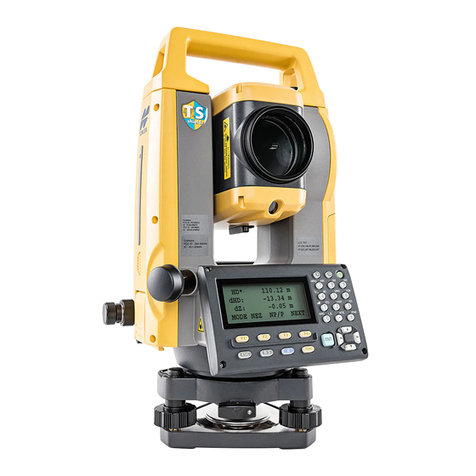
Topcon
Topcon GM-100 Series Quick manual

Rae
Rae VRAE PGM-7800 Operation and maintenance manual
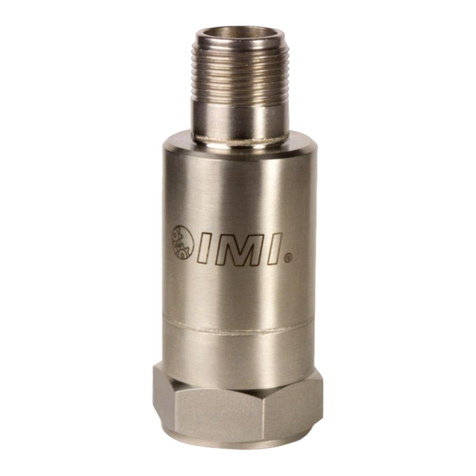
PCB Piezotronics
PCB Piezotronics IMI SENSORS 645B01 Installation and operating manual
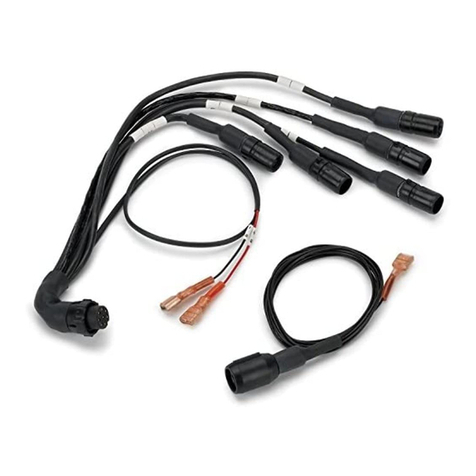
Stack
Stack ST500 manual

Asclepion
Asclepion QuadroStar 532/980 user manual

Taxitronic
Taxitronic Skyglass TX80 installation manual

